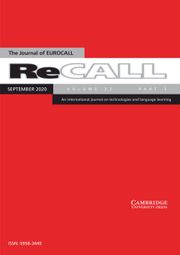Crossref Citations
This article has been cited by the following publications. This list is generated based on data provided by
Crossref.
Virvou, M.
Alepis, E.
and
Troussas, C.
2012.
User Modeling on Communication Characteristics Using Machine Learning in Computer-Supported Collaborative Multiple Language Learning.
p.
1088.
Somers, Harold
2012.
The Encyclopedia of Applied Linguistics.
Troussas, Christos
Virvou, Maria
and
Alepis, Efthimios
2013.
Multiple parameter cluster analysis in a multiple language learning system.
p.
1.
Troussas, Christos
Virvou, Maria
and
Alepis, Efthimios
2013.
Comulang: towards a collaborative e-learning system that supports student group modeling.
SpringerPlus,
Vol. 2,
Issue. 1,
White, Kelsey D.
and
Heidrich, Emily
2013.
Our Policies, Their Text: German Language Students' Strategies with and Beliefs about Web‐Based Machine Translation.
Die Unterrichtspraxis/Teaching German,
Vol. 46,
Issue. 2,
p.
230.
Barr, David
2013.
Embedding technology in translation teaching: evaluative considerations for courseware integration.
Computer Assisted Language Learning,
Vol. 26,
Issue. 4,
p.
295.
Larson‐Guenette, Julie
2013.
“It's just reflex now”: German Language Learners’ Use of Online Resources.
Die Unterrichtspraxis/Teaching German,
Vol. 46,
Issue. 1,
p.
62.
Fredholm, Kent
2014.
Effects of online translation on morphosyntactic and lexical-pragmatic accuracy in essay writing in Spanish as a foreign language.
p.
96.
Troussas, Christos
Virvou, Maria
and
Espinosa, Kurt Junshean
2015.
Intelligent Interactive Multimedia Systems and Services in Practice.
Vol. 36,
Issue. ,
p.
35.
Carreres, Ángeles
Muñoz-Calvo, Micaela
and
Noriega-Sánchez, María
2017.
Translation in Spanish language teaching: the fifth skill/La traducción en la enseñanza del español: la quinta destreza.
Journal of Spanish Language Teaching,
Vol. 4,
Issue. 2,
p.
99.
Rogerson, Ann M.
and
McCarthy, Grace
2017.
Using Internet based paraphrasing tools: Original work, patchwriting or facilitated plagiarism?.
International Journal for Educational Integrity,
Vol. 13,
Issue. 1,
Liu, Xiqin
and
Chen, Xiaowei
2018.
Technology Implementation in Second Language Teaching and Translation Studies: New Tools, New ApproachesMaría LuisaCarrió‐Pastor, Singapore: Springer. 2016. 258 pages. Hardcover €93.59, ISBN 978‐981‐10‐0571‐8, eBook €74.96, ISBN 978‐981‐10‐0572‐5.
International Journal of Applied Linguistics,
Vol. 28,
Issue. 2,
p.
347.
Kol, Sara
Schcolnik, Miriam
and
Spector-Cohen, Elana
2018.
Google Translate in Academic Writing Courses?.
The EuroCALL Review,
Vol. 26,
Issue. 2,
p.
50.
Ducar, Cynthia
and
Schocket, Deborah Houk
2018.
Machine translation and the L2 classroom: Pedagogical solutions for making peace with Google translate.
Foreign Language Annals,
Vol. 51,
Issue. 4,
p.
779.
Nyetanyane, John
and
Masinde, Muthoni
2019.
Emerging Technologies for Developing Countries.
Vol. 260,
Issue. ,
p.
93.
Yang, Yanxia
and
Wang, Xiangling
2019.
Modeling the intention to use machine translation for student translators: An extension of Technology Acceptance Model.
Computers & Education,
Vol. 133,
Issue. ,
p.
116.
O’Neill, Errol M
2019.
Training students to use online translators and dictionaries: The impact on second language writing scores.
International Journal of Research Studies in Language Learning,
Vol. 8,
Issue. 2,
Hoi, Huynh Tan
2019.
Efficiency of Japanese-Vietnamese Translation Job Thanks to the Use of Technology in the Fourth Industrial Revolution.
p.
181.
Pokrivcakova, Silvia
2019.
Preparing teachers for the application of AI-powered technologies in foreign language education.
Journal of Language and Cultural Education,
Vol. 7,
Issue. 3,
p.
135.
Akbari Motlaq, Mohamad Djavad
and
Tengku Mahadi, Tengku Sepora
2020.
ADVANTAGES AND DISADVANTAGES OF USING MACHINE TRANSLATION IN TRANSLATION PEDAGOGY FROM THE PERSPECTIVE OF INSTRUCTORS AND LEARNERS.
Humanities & Social Sciences Reviews,
Vol. 8,
Issue. 4,
p.
121.

